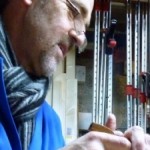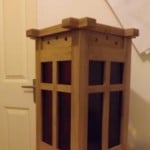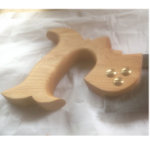Sharpening Milestone
Welcome! / Forums / General Woodworking Discussions / Tools and Tool Maintenance/Restoration / Sharpening Milestone
- This topic has 38 replies, 24 voices, and was last updated 9 years, 1 month ago by
rickcorradini.
-
AuthorPosts
-
 2 July 2013 at 12:15 am #14374
2 July 2013 at 12:15 am #14374I have decided to be committed to do all of my bench chisel and hand plane sharpening by hand, without the help of my “training wheels” aka honing guide.
This is scary for me because I have come to rely on my trusty hone guide.One thing that has driven me to this decision is my stones. I have a good set of Norton water stones (1000, 4000, 8000) that I bought “PrePaul” ….SIDEBAR: There are many things that I bought before I started my “apprenticeship” with Paul i.e. water stones, reversible marking knife, dovetail gauge, couple of specialty hand planes etc.
These are items that Paul later demonstrated that could be bought or better yet made for next to nothing (dovetail marking guide) OR there was a better solution and some of the things I thought I needed, I didn’t. (waterstones)
BUT since they were already purchased, I have decided to use these items. Hence I refer to them as PrePaul as justification for using them.
Back to the water stones
I find that when I use the honing guide, the wheel actually puts ruts in the soft stones and I have to re-flatten the stones after every use. Pain the butt!
So after watching Paul’s sharpening video several times, I decided to bit the bullet and invest in the 3 diamond stones he recommends.After making the holder I ventured today to start on my hand sharpening quest.
My first attempt was less then inspiring as I think I rolled the edge. So I tried again. Felt very sharp and for the first time in my hand planeing history, I cut a curl .001” in curly maple confirmed with my calipers. I have never been able to get below .002” before so I am sold on Paul’s technique.So, I have thrown down the gauntlet. Anybody else up to the challenge of doing away with your honing guide?
 2 July 2013 at 2:13 am #14375
2 July 2013 at 2:13 am #14375I had the opportunity to spend a bit of time with Paul at the Wood Working show in Atlanta a few months back. When I got back home, I built a tray out of plywood to hold my diamond plates that I had previously purchased and went to sharpening without the honing guide and have not picked it up since. I get a good sharp edge every time even though it may not be perfectly square or the precise prescribed angle. My chisels and planes cut extremely well now and allow for a safer and more precise woodworking experience.
So, count me in!
 2 July 2013 at 5:56 am #14377
2 July 2013 at 5:56 am #14377As a chef by trade for more than 25 years, I have always sharpened my knives by hand on stones, as I was shown by my father many years ago, using his pen knife as a demonstrator.
When I took up hand tool woodworking, it never occurred to me to sharpen my chisels and plane irons in any other way; I was so inexperienced and ignorant of all the vast amount of sometimes conflicting information to say nothing of the equally vast array of guides and other such sharpening aids that the possibility of other options or methods just didn’t register.
Having said that, I continue to sharpen my tools the same way, by hand and without guides on a five dollar two-sided stone and a broken piece of Carborundum Razor Hone I got as part of a bunch of old (mostly machinist’s) tools that came with an antique tool chest my wife gave me as a present.
I get the same razor sharp edge with these stones that most people wouldn’t even give a second look that I used to get with my very expensive and stolen-several-years-ago set of Norton oilstones.
Like Steve said, I perhaps do not get the microscopically precise edges that are purported to be possible with honing guides and hundreds of dollars of diamond plates, but what I do get is more than good enough for me. My chisels and plane irons will slice paper thin slices of cherry tomato. (go ahead and laugh if you want. My wife does, too 🙂 ) The only thing I have changed is adding the stropping step demonstrated by Paul. I am honestly not sure if it adds anything to the sharpness of the edge or not ( I suspect that it does) but it certainly can’t hurt and I do love the mirror-sheen polish that it gives the bevels of my cutting tools.
All it takes is practice, patience and the confidence that you can achieve such results by hand. Remember, men of many trades have been using such methods for thousands of years.
I suspect the guides *are* helpful for someone who is new to sharpening, to give one the feel of how a blade must move in relation to the stone/plate/etc. but if you have never sharpened without one, don’t be afraid to put it aside and give hand sharpening a try. Technique is more important than the implements; and the only way to acquire and perfect technique is through practice.

Excellent post Chris.
I was shaving this morning with an old disposable razor, and was thinking of how my grandfather used to shave with a cut-throat razor. He must have been able to get that razor very sharp, otherwise he’d have soon grown a beard to avoid the pain of a blunt razor!
Recently my Dad gave me some old sickles which I’ve cleaned and sharpened. They are much more useful than a strimmer. Most men living in the country would have mastered the art of sharpening a sickle with a stone.
Using a sharp hand tool is such a pleasure, – it would be a shame if we lose the skill of sharpening by hand, and don’t pass it on to our children. 2 July 2013 at 10:47 am #14387
2 July 2013 at 10:47 am #14387Great post!
I have also been sharpening without a guide for the last couple of weeks. While chopping the mortises for the coffee table legs I was sharpening my chisel after every one or two mortises (Narex chisels don’t hold their edge long while chopping oak!), which would have been such a pain if I had to set up a guide each time.
Instead, I’ve been using the super fine diamond stone to get a new edge, stropping, then getting back to work. One minute is all it takes. My technique is still far from perfect and I may have to grind a new bevel on a couple of chisels once the project is finished but I can keep my tools more than sharp enough for the job without a guide this way, and my technique is improving all the time.
George.
 2 July 2013 at 8:57 pm #14389
2 July 2013 at 8:57 pm #14389thanks for that george.i thought it was just me when my narex chisel kept on losing its edge so quickly when chopping oak however when i used a honing guide i did get better longevity i use the micro bevel system i know is slow but i find free hand sharpening difficult and very hit and miss. i believe the convex bevel paul creates is right behind the cutting edge which provides that needed strength. i find mine is either very sharp but brittle or just dull.i am getting excellent results with a guide but hope to eventually move to freehand
Once again we have the old debate of free hand vs honing guides. Nothing wrong with either method, do what works for you. What is wrong is people thinking anyone that dose not use the free hand method is wrong, well its freedom of choice I use a honing guide and the micro bevel, takes me 6 seconds to put a chisel in the jig, I can live with that.
Bottom line freehand, honing guide, makes no difference to me, but I would never knock anyone for doing it different. Do what you want to do and let others do the same.
Cheers 😉

 2 July 2013 at 11:34 pm #14397
2 July 2013 at 11:34 pm #14397Absolutely, Ken. I hope I didn’t come across as trying to portray the use of guides etc. as “wrong”…I agree completely that everyone should do what works for them.
I guess the point of my rather long-winded response above was merely to encourage anyone who was thinking of trying free hand sharpening and to say there was no reason for anyone to think they *can’t* do it that way…If sharpening with a honing guide was how I originally learned, I’m sure I’d probably favor *that* method, myself.
Hey Chris, I agree you should give them all a try. I have tried Paul’s method and it’s not for me, I think I must have tried them all at one time.
The honing guide, and micro bevel is the one I feel at home with. If you feel happy with Paul’s method, or Rob Cosman’s thats great stick with it.
No matter which way we work, if we get a nice sharp chisel or plane Iron at the end of it, then job done. 🙂
 3 July 2013 at 5:54 am #14405
3 July 2013 at 5:54 am #14405I use a bit of everything .
I must admit I like sharpening and it dose detract from doing woodworking
I have a Tormek T7 great for getting things to a nice start and even in its own right gives a good edge.
I have diamond plates corse medium and fine. Get a reasonable edge but have never felt that it is super sharp.
I have my old stones had for years I get a pretty good edge with them.
Lastly I have scary sharpening kit must use a guide for this system. Out of all the systems I use I find this to have the sharpest results.
I still would like to try water stones or ceramic.
I would hate to think how long it would take to sharpen all my tools with over 100 different chisels and about 30 odd planes with cutters.
In the end what ever you are happy with.
@nobby1967 [quote quote=14405]I have diamond plates coarse medium and fine. Get a reasonable edge but have never felt that it is super sharp[/quote]
Mark, I use the coarse, fine, and extra fine, followed by leather strop. may fine is not fine enough?
 4 July 2013 at 11:58 am #14455
4 July 2013 at 11:58 am #14455Don’t get me wrong Robin Diamond plates good enough.
My fine is 15 micron 1000g and I do strop with a polishing compound. I agree super fine may make a little difference. I also do free hand have been doing so for years also using my oil stones.
There is nothing like having a newly ground primary bevel on chisel or iron then putting the first micro bevel on. Then putting a bit of wood in vise pairing chisel on end grain can do for hours or new Iron in plane and getting the finest see through shavings 🙂
This subject will always cause a big debate.
I use more than one method for quickness Diamond plates win keep you woodworking. For the ultimate edge I think other methods are better. Like I said I enjoy sharpening and is a craft in its own right.
Well, I’m just getting started using a hand plane and chisels. The tools I have are only manufacturer-sharp, and beginning to get dull. I don’t own any sharpening devices yet, and can’t decide whether to spend the money on diamond stones or Japanese water stones, or just use glass and sand paper. Paul mentioned recently that a reasonably good and acceptable edge on a plane iron could be obtained with the use of only 250 grit sand paper. With that in mind, what recommendations do any of you have about the possibility of my obtaining only
-
two stones
(whichever, diamond or water stone): a coarse one, say 400 grit and a final one, say 1000 grit and stopping there? My chisels are inexpensive and my #4 jack plane is cheap-o, so I don’t have to worry too much about ruining a fine tool. A man’s gotta start somewhere. Your opinions and advice will be much appreciated.
Thanks,
Dick Aldridge
 14 May 2014 at 2:49 pm #57119
14 May 2014 at 2:49 pm #57119Hi,
Until I was able to buy the diamond stones, I followed the sand paper and glass method. It works well. And as seen in the variuos videos here, you really don’t need to sharpen to super high grits. I got nice results using these. Beautiful even shavings.
I first got the coarse diamond stone and continued to use sandpaper for the higher grits.
Later I was able to buy the fine stone.
I now use 2 diamond stones: coarse and fine, with stropping as well.The superfine stone is still on my list to buy, but will have to wait since there are more essential tools higher up on my list.
Hope this helps…
Marilyn
p.s. I bought the eze lap diamond stones…
-
AuthorPosts
- You must be logged in to reply to this topic.
